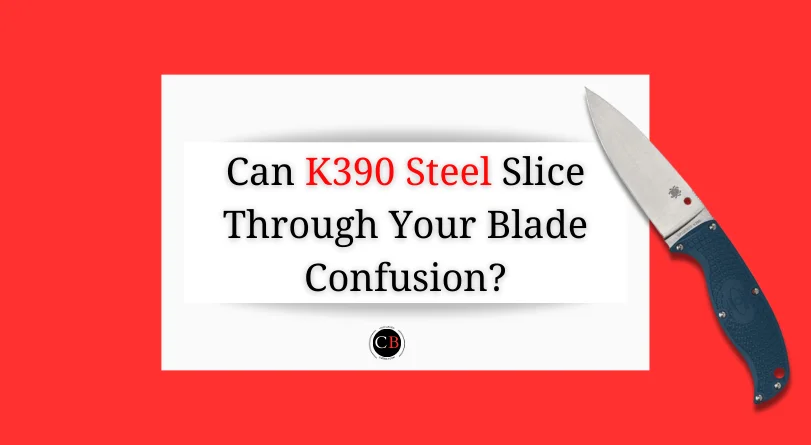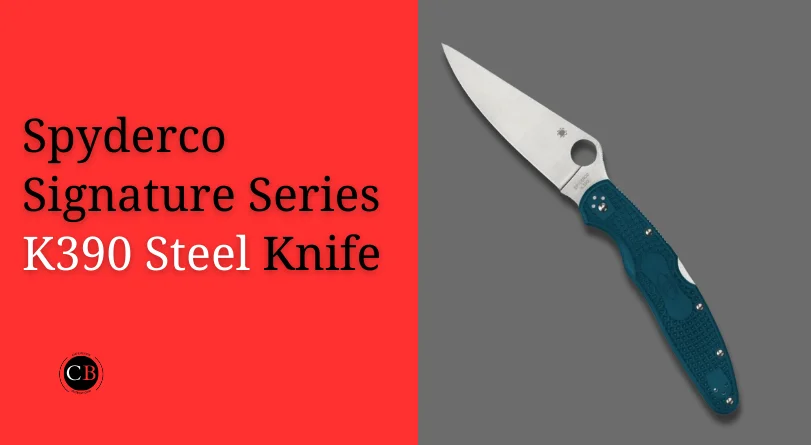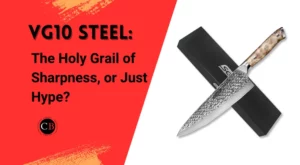Ever heard of K390 steel? Knife enthusiasts whisper its name with reverence, praising its edge that stays sharp for weeks, even after tackling cardboard jungles and frozen meats. But is it all hype, is K390 steel good for knives? Or is K390 truly the steel unicorn?
As a knife nut who’s put countless blades to the test, I dove deep into this marvel. Prepare to be surprised by its strengths (hint: it can take a beating!), but also its quirks (spoiler alert: sharpening’s no walk in the park). Come explore the world of K390 steel and see if it deserves a place in your pocket or kitchen!
What is Bohler K390 MICROCLEAN?
Bohler K390 MICROCLEAN is a high-performance cold work steel with high vanadium content. It is a powder metallurgy tool steel renowned for its exceptional wear resistance, toughness, and edge retention. Developed by Bohler-Uddeholm, a leading manufacturer of specialty steels, K390 MICROCLEAN is specifically engineered for demanding applications in industries like metalworking, woodworking, and, notably, knife making.
The “MICROCLEAN” designation indicates a refinement process that ensures the steel’s microstructure is free from impurities, enhancing its overall performance and consistency. This refinement contributes to K390’s ability to maintain a razor-sharp edge even under heavy use, making it a preferred choice for users who demand precision and longevity from their blades.
In essence, Bohler K390 MICROCLEAN represents the pinnacle of modern steel technology, offering knife makers and users alike a cutting-edge solution for their most challenging cutting tasks.

Bohler K390 MICROCLEAN – chemical composition
| Element | Portion | Effect |
| Carbon | 2.47% | Improves hardness, wear and corrosion resistance; but too much reduces the strength. |
| Chrome | 4.25% | Improves tensile strength and edge retention as well as corrosion resistance and wear resistance. |
| Molybdenum | 3.80% | Improves machinability and strength. |
| Vanadium | 9.00% | Increases the wear resistance of the knife, important in the powder metallurgy process for even grain distribution. |
| Wolfram | 1.00% | Increases the wear resistance of steel by compensating for the negative influence of chromium on it. |
| Manganese | 0.40% | Improves hardness and tensile strength. |
| Silicon | 0.55% | Improves strength. |
| Cobalt | 2.00% | Strengthens the individual effects of other components. |
As you can see the chemical composition of Böhler K390 MICROCLEAN is a mixture of vanadium, carbon, molybdenum and chromium with a high content of vanadium, which provides high toughness and wear resistance.
The hardness of K390 steel (Rockwell hardness)
According to Böhler, K390 MICROCLEAN can reach a maximum hardness of 65 HRC, but more realistic, or more practical, is a hardness range of 58 to 64 HRC with 61 on average.

Properties of K390 steel
Depending on the chemical composition and hardness of the steel, Böhler K390 MICROCLEAN has the following characteristics:
1. Excellent edge retention
Clocking in at 61 HRC, K390 steel packs a punch thanks to its blend of vanadium, carbon, molybdenum, and chromium. This powerhouse combo delivers top-notch hardness and impressive cut resistance. But the real star of the show is K390’s unmatched edge retention. Packed with vanadium carbides (courtesy of the generous carbon and vanadium content), K390 blades stay sharper, longer, slicing through tasks with ease.
2. Good corrosion resistance
K390 might not wear a “stainless” badge, thanks to its lower chromium content. But don’t fret, its 4.25% chromium still offers decent rust resistance, so spontaneous stains aren’t a worry. However, if a completely rust-proof blade is your holy grail, K390 might not be the knight in shining armor you seek. Remember, a little TLC goes a long way!
3. Wear resistance
Forget frequent sharpening worries! K390 steel boasts a whopping 9% vanadium content, acting like a superhero shield against wear and tear. This Bohler marvel translates to blades that stay sharp for years, conquering countless cuts with unwavering performance.
4. Sharpness
Brace yourself, sharpening enthusiasts! K390’s impressive hardness, while delivering edge-holding nirvana, also means sharpening isn’t exactly a walk in the park. Don’t worry, it’s not impossible!
Advanced sharpening systems can definitely revive a dull K390 blade, just expect to invest more time compared to softer steels. Think of it as a trade-off: longer-lasting sharpness demands a bit more sharpening effort.
5. Machinability
Another notable characteristic of K390 steel is its excellent machinability. With consistent mechanical properties, it surpasses many other steels in ease of machining. This attribute is highly valued by cutlers who choose this steel for crafting knives. Böhler explicitly acknowledges its exceptional machinability as a significant advantage of K390 steel.
6. Toughness
The higher the hardness of a material, the less it can endure impact and lateral forces, and K390 steel is no exception. With its elevated hardness, it exhibits lower toughness.
Nevertheless, it’s important to clarify that K390 still possesses sufficient toughness to tackle most demanding cutting tasks effectively. However, caution is advised when it comes to activities like “batoning” (using a wooden mallet to strike the knife as a makeshift hammer to split wood), as there’s a risk of sudden breakage or deformation, which would be regrettable.

Steels similar to K390
The steel most akin to Böhler K390 MICROCLEAN is likely S90V, as noted here, with one notable difference: corrosion resistance. S90V surpasses K390 in this aspect. However, both steels share similarities in high edge retention and hardness, attributed to their 9% vanadium content. Additionally, they exhibit comparable wear resistance and are classified within the same high-end price range for steels.
Here is a comparison between K390 and S90V steel:
| Feature | K390 | S90V |
|---|---|---|
| Alloy Type | High Vanadium High Chromium Tool Steel | High Vanadium Tool Steel |
| Vanadium Content (%) | 9 | 9 |
| Chromium Content (%) | 4.25 | 14 |
| Hardness (HRC) | 60-64 | 57-60 |
| Edge Retention | Excellent | Excellent |
| Wear Resistance | Excellent | Very Good |
| Toughness | Very Good | Good |
| Sharpening Difficulty | High | High |
| Corrosion Resistance | Moderate | Poor |
| Cost | High | High |
| Applications | High-end kitchen knives, pocket knives, EDC blades, tactical knives, cold work tools | High-end kitchen knives, pocket knives, EDC blades, tactical knives |

Is K390 a good knife steel?
Think of high hardness, incredible wear resistance, and edge retention that lasts for ages – that’s K390 steel in a nutshell. This high-end tool steel conquers almost any cutting task, except for highly corrosive environments where LC200N or H1 shine.
But hold on, “best” is always subjective. While K390 excels in demanding cuts and short-term adventures like camping, longer wilderness journeys might call for a different hero. Why? Sharpening K390 on river pebbles can be frustrating, and wilderness adventures often demand adaptability.
Remember, the perfect steel depends on your specific needs. K390 might be a champion, but choose wisely based on your cutting adventures!
K390 vs M390 Steel
| Discipline | Böhler K390 | Böhler M390 |
| Edge retention | 8/10 | 8/10 |
| Simplicity of sharpening | 4/10 | 5/10 |
| Corrosion resistance | 3/10 | 8/10 |
| Toughness | 6/10 | 6/10 |
M390 has the same cutting ability and toughness but the corrosion resistance is much higher compared to K390.

K390 vs CPM M4 Steel
| Discipline | Böhler K390 | CPM M4 |
| Edge retention | 8/10 | 8/10 |
| Simplicity of sharpening | 4/10 | 3/10 |
| Corrosion resistance | 3/10 | 3/10 |
| Toughness | 6/10 | 6/10 |
At first glance, they seem almost identical, but the differences in reality are revealed in details. More about that in the conclusion.
My opinion: Is K390 steel good for knives?
Joining the ranks of “super steels,” K390 wins over legions of users with its impressive performance. Dive into online forums and YouTube comments, and you’ll see a wave of K390 satisfaction.
Now, here’s the catch: it’s not stainless. Corrosion resistance requires some TLC, occasional oiling to stave off rust. But compared to close competitor CPM M4, K390 holds its edge geometry better, especially regarding Spyderco models. Plus, Spyderco’s K390 blades seem to boast higher hardness than their M4 counterparts.
Price-wise, the gap has narrowed (check Spyderco’s pricing), making the decision even trickier. Want to save a few bucks on high-quality blades? Explore the S…V family: S110V, S90V, or S30V are solid options.
Ultimately, the “best” steel depends on your needs. K390 offers phenomenal performance, but its quirks might not suit everyone. Consider your tolerance for maintenance and budget alongside your cutting demands before adding this “super steel” to your collection.



